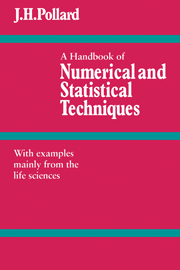Book contents
- Frontmatter
- Contents
- List of statistical and mathematical tables
- Preface
- PART I BASIC NUMERICAL TECHNIQUES
- PART II BASIC STATISTICAL TECHNIQUES
- 8 Probability, statistical distributions and moments
- 9 The normal and related distributions
- 10 The common discrete distributions
- 11 The Pearson system of probability-density functions
- 12 Hypothesis testing
- 13 Point and interval estimation
- 14 Some special statistical techniques
- PART III THE METHOD OF LEAST SQUARES
- Appendix
- References
- Author index
- Subject index
11 - The Pearson system of probability-density functions
Published online by Cambridge University Press: 18 December 2009
- Frontmatter
- Contents
- List of statistical and mathematical tables
- Preface
- PART I BASIC NUMERICAL TECHNIQUES
- PART II BASIC STATISTICAL TECHNIQUES
- 8 Probability, statistical distributions and moments
- 9 The normal and related distributions
- 10 The common discrete distributions
- 11 The Pearson system of probability-density functions
- 12 Hypothesis testing
- 13 Point and interval estimation
- 14 Some special statistical techniques
- PART III THE METHOD OF LEAST SQUARES
- Appendix
- References
- Author index
- Subject index
Summary
Summary The Pearson system of probability-density functions is defined by a differential equation similar in form to the difference equation of the hypergeometric distribution. By varying the parameters in the equation, it is possible to produce continuous distributions with different levels of skewness and kurtosis. The parameters are completely defined in terms of the first four moments, and the first four sample moments are used for curve-fitting purposes. The technique is convenient if one just wants to fit a curve without worrying about the justification of the functional form.
Introduction
Many different shapes of discrete distribution can be obtained by varying the parameters R, B and n in the hypergeometric distribution (section 10.13). When, for example, R = B and both are very large, and a reasonably large random sample of size n is drawn, the distribution of the number of red objects chosen is effectively binomial with parameters n (large) and p = ½. We then have a symmetric discrete distribution closely resembling the normal. By varying the hypergeometric parameters, we are able to produce distributions with different levels of skewness and kurtosis (section 8.6). Karl Pearson observed this, and he devised the Pearson system of probability-density functions by using a differential equation similar to the difference equation of the discrete hypergeometric distribution.
The process of fitting a Pearson probability-density function usually involves a large amount of arithmetic, but the work is nowhere near as onerous as previously now that electronic desk calculators are available with exponential, logarithmic and trigonometric keys.
- Type
- Chapter
- Information
- A Handbook of Numerical and Statistical TechniquesWith Examples Mainly from the Life Sciences, pp. 122 - 132Publisher: Cambridge University PressPrint publication year: 1977
- 2
- Cited by



